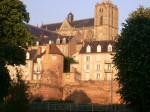 Archaeologists excavating a tract of land outside what is now Le Mans, France, but was once Vindunum, Gaul, in preparation for future construction have discovered a large, rich temple complex dating from the 1st to the 3rd century A.D. Most of the stone structure is long gone, doubtless recycled into a couple thousand years worth of local buildings, but what remains indicates a large site which would have been able to accommodate hundreds, if not thousands, of worshipers.
Archaeologists excavating a tract of land outside what is now Le Mans, France, but was once Vindunum, Gaul, in preparation for future construction have discovered a large, rich temple complex dating from the 1st to the 3rd century A.D. Most of the stone structure is long gone, doubtless recycled into a couple thousand years worth of local buildings, but what remains indicates a large site which would have been able to accommodate hundreds, if not thousands, of worshipers.
The shape of the buildings were first spotted from aerial views. Archaeologists followed the shapes with some exploratory digs on the ground. Once they realized there weren’t many in the way of walls to harm, they sent in mechanical diggers to peel off the wheat fields from the sanctuary foundations.
At the entrance to the site, there once stood a large E-shaped building, probably for welcoming the pilgrims, selling religious objects and housing the temple guardians. One wide path littered with iron slag (Vindunum was a major metalworking centre), leads a few hundred metres south to the foundations of a circular fanum (temple) about 12 metres in diameter. That round shape was rare in Gallo-Roman times and there are only a few such examples in France.
In fact, three temples were erected successively during the second and third centuries. Possibly they had to be rebuilt because of the instability of the ground. A pergola and a flight of steps would have led to the temple, which had stone walls around seven metres high covered by a tiled roof. Inside, the cella (central room) housed the statue of the god.
Another fanum stood at the west, the oldest in the sanctuary, dating to the first century. It was square, 15 metres wide and apparently in the Celtic temple tradition. This one was originally built in wood and stone added later, together with a cella surrounded by a gallery for circumambulation and a wall separating the sacred space from the profane. Fragments of coloured plaster show that the walls were once panted. The temple was surrounded by octagonal or square-shaped secondary “chapels”.
This Celtic fanum is where archaeologists found the most artifacts. Most likely offerings made to the deities, the finds include Gallic, Celtic and Roman silver coins, broaches, rings, keys, pottery, weapons and heavy work tools like sledgehammers and hammers. Metal workers and soldiers would have had good reason to offer valuable implements of their trade to the gods, given how dangerous their jobs were.
Archaeologists didn’t find any offerings in the circular temple, but they did find something completely unexpected: graves. Romans didn’t bury the dead on temple grounds. They didn’t even bury them inside the city walls. Dead bodies were not considered pure, and temples had to be.
Vindunum was a major Gallo-Roman city in the first few centuries A.D. It had a large bath complex — demolished in the third century and the stone used to build the walls encircling the city — and an amphitheater built about the same time as the walls. (Fun fact: it’s also where Henry II of England was born. The well-preserved medieval old town is known as Cité Plantagenêt.)